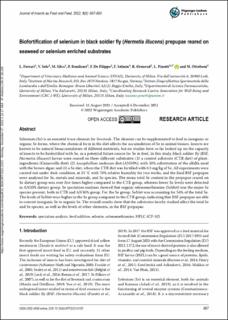| dc.description.abstract | Selenium (Se) is an essential trace element for livestock. The element can be supplemented to feed in inorganic or organic Se forms, where the chemical form in the diet affects the accumulation of Se in animal tissues. Insects are known to be natural bioaccumulators of different nutrients, but no studies have so far looked up on the capacity of insects to be biofortified with Se, as a potential future source for Se in feed. In this study, black soldier fly (BSF, Hermetia illucens) larvae were reared on three different substrates: (1) a control substrate (CTR diet) of plant-ingredients (Gainesville diet); (2) Ascophyllum nodosum diet (AN30%), with 30% substitution of the alfalfa meal with the brown algae; and (3) a Se diet, where the CTR diet was fortified with 0.3 mg/kg of Se. All experiments were carried out under dark condition, at 25 °C with 70% relative humidity for two weeks, and the final BSF prepupae were analysed for Se, metals and minerals, and Se species. The mean total Se content in the prepupae reared on Se dietary group was over five times higher compared to the CTR group, whereas lower Se levels were detected in AN30% dietary group. Se speciation analyses showed that organic selenomethionine (SeMet) was the major Se species present, both in CTR and AN30% group. For the Se group, SeMet was accounting for 54% of the total Se. The levels of SeMet were higher in the Se group compared to the CTR group, indicating that BSF prepupae are able to convert inorganic Se to organic Se. The overall results show that the substrates hereby studied affect the total Se and Se species, as well as the levels of other elements, in the BSF prepupae. | en_US |
